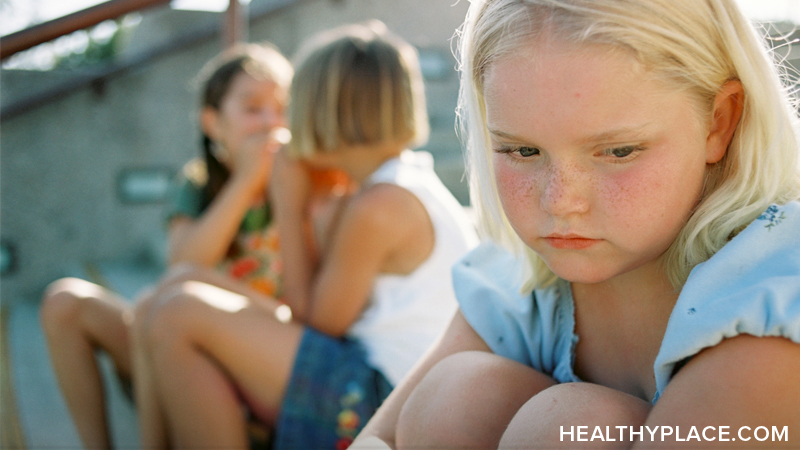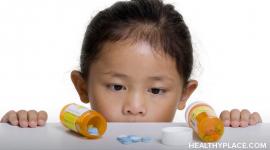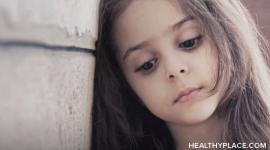Bipolar Disorder in Children: Signs, Symptoms, Treatment

There is medical debate about whether bipolar disorder should be diagnosed in children as currently, there are no specific symptoms for bipolar disorder in children, only for adult bipolar disorder. Moreover, many clinicians believe bipolar disorder cannot be diagnosed in pediatric patients.
However, research suggests 20% - 30% of adults with bipolar disorder type 1 first showed symptoms before the age of 20. (Read "Childhood Bipolar Disorder: Growing Up A Bipolar Child") Additionally, 20% of youths diagnosed with depression later go on to experience a manic episode.2
Symptoms of Bipolar in Children
Bipolar disorder in children and teens is difficult to recognize because it does not precisely fit the symptom criteria established for adults, and its symptoms can resemble or co-occur with those of other common childhood-onset mental disorders. In addition, symptoms of childhood bipolar may be initially mistaken for normal emotions and behaviors of children and adolescents. But unlike normal bipolar symptoms and mood changes, bipolar disorder significantly impairs functioning in school, with peers, and at home with family.
There appears to be an equal number of male and female children with bipolar disorder but males are more frequently referred for treatment.
In their book The Bipolar Child: The Definitive and Reassuring Guide to Childhood's Most Misunderstood Disorder, Demitri and Janice Papolos suggest the following symptoms of bipolar disorder in children:
Very common in childhood bipolar:
- Separation Anxiety
- Rages and Explosive Temper Tantrums (lasting up to several hours)
- Marked Irritability
- Oppositional Behavior
- Frequent Mood Swings
- Distractibility
- Hyperactivity
- Impulsivity
- Restlessness/ Fidgetiness
- Silliness, Goofiness, Giddiness
- Racing Thoughts
- Aggressive Behavior
- Grandiosity
- Carbohydrate Cravings
- Risk-Taking Behaviors
- Depressed Mood
- Lethargy
- Low Self-Esteem
- Difficulty Getting Up in the Morning
- Social Anxiety
- Oversensitivity to Emotional or Environmental Triggers
Common symptoms in bipolar children:
- Bed-Wetting (especially in boys)
- Night Terrors
- Rapid or Pressured Speech
- Obsessional Behavior
- Excessive Daydreaming
- Compulsive Behavior
- Motor & Vocal Tics
- Learning Disabilities
- Poor Short-Term Memory
- Lack of Organization
- Fascination with Gore or Morbid Topics
- Hypersexuality
- Manipulative Behavior
- Bossiness
- Lying
- Suicidal Thoughts
- Destruction of Property
- Paranoia
- Hallucinations & Delusions
Less frequent symptoms for children with bipolar disorder:
- Migraine Headaches
- Bingeing
- Self-Mutilating Behaviors
- Cruelty to Animals
It's important to remember a childhood bipolar diagnosis is an expert opinion and not all experts will agree on what fits a child best. As more is learned about bipolar disorder in children, diagnoses and treatments are likely to change.
(Read here: how is bipolar disorder diagnosed in adults?)
How Common is Bipolar Disorder in Children?
The true number is not known as there are no diagnostic criteria defined for bipolar disorder in children and there is insufficient study data. However, one estimate suggests bipolar disorder affects 0.2% - 0.4% of children.2
There is a real concern, however, of the overdiagnosis of bipolar in children. Recent U.S. trends show as much as a 40-fold increase in bipolar diagnosis in youth under the age of 20 and four times the number of inpatient psychiatric hospitalizations of youth with bipolar disorder.3
Other Illnesses in a Bipolar Child
Bipolar kids may be misdiagnosed or have co-occurring illnesses. Even when a child's behavior is unquestionably not normal, correct diagnosis remains challenging. Bipolar disorder is often accompanied by symptoms of other psychiatric disorders. Attention deficit/hyperactivity disorder (ADHD) appears to be the most common in bipolar children with almost 90% of children with bipolar disorder also having ADHD.
Additional diagnoses that mask or sometimes occur along with bipolar in children include:
- Depression
- Conduct disorder (CD)
- Oppositional-defiant disorder (ODD)
- Panic disorder
- Generalized anxiety disorder (GAD)
- Obsessive-compulsive disorder (OCD)
- Tourette's syndrome (TS)
- intermittent explosive disorder
- Reactive attachment disorder (RAD)
Find more information on these and other childhood psychiatric disorders.
Treatment of Bipolar Disorder in Children
A good treatment plan for child bipolar disorder includes:
- Medication
- Close monitoring of symptoms
- Education about the illness
- Counseling or psychotherapy for the individual and family
- Stress reduction
- Good nutrition
- Regular sleep and exercise
- Participation in a network of support.
Utilizing a comprehensive treatment plan leads to the best chance of childhood bipolar recovery. Factors that contribute to a better treatment outcome include:
- Access to competent medical care
- Early diagnosis and treatment
- Adherence to medication and treatment plan
- Flexible, low-stress home and school environment
- Supportive network of family and friends
Medication for children with bipolar disorder is similar to that given to adults with bipolar disorder. Bipolar medication choices include mood stabilizers and antipsychotics for bipolar like:
Medications in bipolar children are generally off-label because very few drugs are FDA approved for the treatment of children.
The good news is with appropriate treatment and support at home and school, many children with bipolar disorder achieve a marked reduction in the severity, frequency and duration of episodes of illness.
APA Reference
Tracy, N.
(2021, December 28). Bipolar Disorder in Children: Signs, Symptoms, Treatment, HealthyPlace. Retrieved
on 2026, January 3 from https://www.healthyplace.com/bipolar-disorder/bipolar-children/bipolar-disorder-in-children-signs-symptoms-treatment



